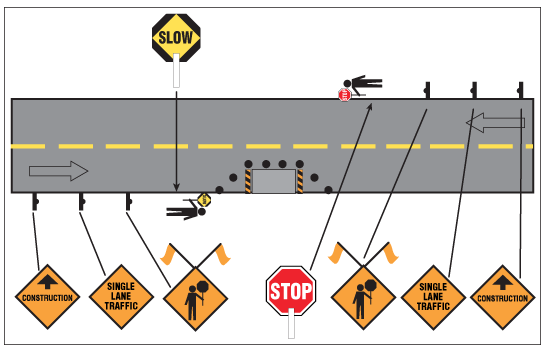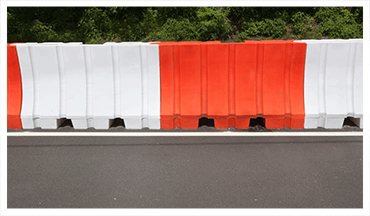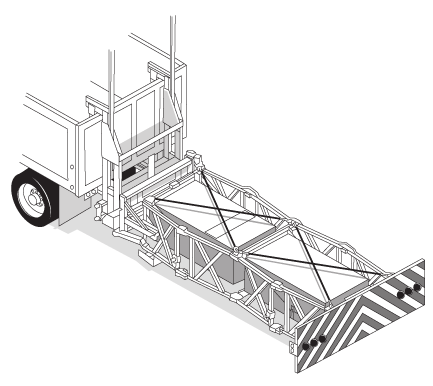Road Work - Traffic Control Zone
On this page
- What is covered in this document?
- What is a traffic management plan?
- How is traffic control managed?
- What is a traffic control layout for temporary work zones?
- What should be done when setting up a work zone?
- What kind of safety devices are used in traffic control layouts?
- What type of personal protection equipment is recommended?
- What are general tips when working on or near roads?
What is covered in this document?
Back to topThis document covers managing traffic flow through a work zone. Construction, maintenance, utility workers, landscaping, emergency workers, and all other occupations who may conduct activities on or along the road are exposed to hazards such as:
- collision with traffic or work vehicle, especially at high speeds
- weather conditions
- exposure to vehicle exhaust
- moving machinery and equipment
- angry motorists
Traffic control refers to the use of temporary traffic control devices to protect workers and to move road users safely through a work zone. A traffic management plan is usually required to outline the traffic hazards and to specify the measures needed for traffic control. Health and safety legislation focuses on safety requirements, including increased visibility of the workers, signage, and signalling.
A general approach to traffic control is discussed in this document. Always consult with your jurisdiction for specific requirements.
What is a traffic management plan?
Back to topA traffic management plan is usually required to outline the traffic hazards and specify the measures needed for traffic control. A traffic management plan can be defined as: “the strategies designed to safely mitigate the impact of construction, rehabilitation, maintenance, incident management and special events on roadways to maintain mobility and worker safety.” (From: British Columbia Ministry of Transportation and Infrastructure).
Plan the traffic diversion so that the flow of traffic ensures the safety of the workers, and the road work does not endanger the other road users.
Plan the traffic diversion in the work zone to take into account:
- the type of work and how much of the road will be closed
- the duration of the work (long,short,very short, stationary or mobile work)
- the hours in which the work will take place
- the classification of the road (e.g., highway, non-highway)
- the legal maximum speed limit
- the location such as urban/rural road
- the number of vehicles that will use the road in a day (traffic volume)
- the road surface (in general, and during construction, such as loose gravel)
- any pedestrians or cyclists that could pass through or near the work zone
The traffic management plan should include:
- the hazards related to the vehicle traffic
- written procedures for setting up, maintaining, and removing the work zone
- roles and responsibilities in setting up, maintaining, inspecting, and removing the work zone
- the layout of the work zone (provisions must be made for flexible layouts as needs may change as the work progresses)
- the maximum speed allowed for vehicles throughout the work zone
- types of signalling or traffic control devices to be used and their location
- management of any hazards created by the road work (e.g., dust, falling rock, loose gravel, potholes, etc.)
- a communication strategy to inform the public in advance (where possible) about road work and temporary traffic diversion
- the procedures in case of an incident
How is traffic control managed?
Back to topTraffic control is managed through three systems:
- traffic control devices: signs, signals, lighting, flares, blocker trucks, crash trucks, pavement markings, channelizing devices, barriers, barricades, etc.
- traffic control layout
- traffic control persons, which includes their responsibilities, conduct, clothing, equipment, communications, and safety
Wherever possible, the hierarchy of controls should be used.
Elimination Controls: Ideally, the elimination of the hazards should start at the design phase by considering structures, materials, processes, and measures that would allow for minimal and safe maintenance. When planning a work activity that would close part of the road, consider if it is possible to close the road completely. Are alternate routes available?
Engineering Controls: If total closure is not possible, physically separate the workers and the vehicles. Use barriers or other devices to channel traffic, and, where possible, provide a physical separation between the work zone and passing traffic. Install overhead lighting to illuminate the workplace if working overnight or in low-light conditions.
Administrative controls: In addition to engineering controls, develop a written traffic management plan. If possible, plan most of the work during non-peak hours or nighttime when the traffic is light. Try to coordinate road work with other necessary works (e.g., tree clearing) to minimize the length of time the road is obstructed.
Appoint a competent supervisor to establish and monitor the work zone. Communicate the plan to the workers, and train the workers who will work, set up, install, and remove the signals or barriers in the area. Attention must be given to the setup and installation phase since those workers will be exposed to an increased risk of injury.
Personal Protective Equipment: Workers must wear personal protective equipment, including high visibility clothing as appropriate for the situation and time of day/night.
What is a traffic control layout for temporary work zones?
Back to topWhen work is conducted on the road, the work zone is not limited only to the area where the actual work is done but extends to all areas where devices that guide the traffic are used.
A typical layout for a temporary work zone has the following sections:
- Advanced warning area – alerts the road users about road work ahead.
- Approach area – informs users of traffic changes (speed, lane reduction, lane diversion, etc.).
- Transition area – channels the traffic to a new path.
- Longitudinal buffer area – the area of a project between the end of a lane closure taper and the start of a work area which provides protection for road users and workers by allowing drivers the space necessary to slow down before entering the actual work area.
- Work area – the area where the work takes place, and all materials are stored.
- Termination area – allows traffic to transition back to the normal path of the road.
Depending on the extent of the work and the road type, the requirements for each area will vary. Check the requirements in your jurisdiction for detailed information on the layout requirements for different situations. The figure below illustrates a sample layout for a lane closure with traffic control persons on a two-lane two-way road.

Figure 1: Lane closure with traffic control persons on a two-lane two-way roadway
What should be done when setting up a work zone?
Back to topWhen setting up the work zone:
- Clearly identify the work zone with signage as required in your jurisdiction.
- Design the work zone in such a way that the workers will be visible to all drivers (e.g., vehicles passing through, work vehicles, etc.). Remember that the driver’s sight lines will vary from location to location depending on the curve of the road, hills/valleys, or objects/buildings beside the road.
- Use barriers, barricades, markers, cones, etc., to guide traffic and to protect workers.
- Drivers must be given clear guidance on how to proceed through the work zone.
- Cover the permanent traffic signs and markings if temporary markings and signs are used.
- Ensure that any signs, devices, or barriers are visible in all varying conditions of light and weather.
- Make sure that the work zone is indicated in advance so that the incoming traffic has time to adjust their speed and plan for a change of lane.
- If necessary, ask the road authority to reduce the speed limit in the work zone.
When traffic control persons are required, workers should only direct traffic from one lane in the same direction. This person must:
- be competent.
- not do any other work while directing traffic.
- be in a position that places them at the lowest risk from the traffic.
- be given written and oral instructions, and if necessary in a language that she or he understands. The instructions must include how to direct traffic and the signals to be used.
- have a general knowledge of vehicle operations, rules of the road, and an understanding of driver expectations.
See Road Work - Traffic Control Person for more information on traffic control persons.
What kind of safety devices are used in traffic control layouts?
Back to topThe equipment used to ensure safety in the work zone can be grouped into three categories: warning or information, closure/guidance, and protection.
Warning or information includes items such as fixed or mobile traffic signals or signs, flashing arrow boards, or temporary rumble strips.
Closure/guidance includes items such as traffic cones, drums, and barricades.
The cones and barrels guide the traffic, but cannot protect the workers against collision. The spacing between the cones or drums can vary and depends on the type of work and the speed of the road. Place cones so that there is no confusion on the part of the drivers where they are to travel. Cones are usually used on non-freeways, or for short operations on freeways. Flexible drums are preferred for highway work zones and are required for night-time operations on highways.
Barricades are used to temporarily close or block off a portion of a road. They may be easily tipped over by wind and motorists if they are not well secured firmly in the position (usually by sandbags). A better option for traffic guidance is a channelling device or continuous barrier (see protection below).
Protection includes the protection of the workplace through the use of physical barriers such as concrete barriers, crash trucks, and crash cushions.
For example, continuous physical barriers are made from concrete or deformable elements filled with ballast and reinforced by steel bars. Concrete barriers must not be placed at an angle or perpendicular to the direction of traffic.

Figure 2: Interconnecting channelizing device
Buffer vehicles are used to protect workers during short-duration or mobile work. Some buffer vehicles can be equipped with attenuators that reduce the force of the impact in case of a crash. These types of buffer trucks are also known as crash trucks.

Figure 3: Vehicle-mounted crash attenuator
Temporary crash cushions absorb the energy of a collision, have the advantage of being easily restored, and can be used in temporary situations where quick setup and removal the work zone is needed.
What type of personal protection equipment is recommended?
Back to topThe personal protection equipment must be adequate for the job. Road workers should generally wear a hard hat with retro-reflective striping, CSA-certified protective footwear, and a highly visible vest or clothing. In general, you should wear high-visibility clothing that complies with the CSA Standard Z96-22 High-Visibility Safety Apparel.
Consult the CSA Standard or check with your provincial legislation for specific requirements.
What are general tips when working on or near roads?
Back to top- Do not work on the edge or outside of the work zone.
- Do not unload or load a vehicle from the side with active traffic.
- Work facing oncoming traffic.
- Appoint, as necessary, a traffic control person who meets the training requirements established by the regulatory body.
- If a traffic control person is deemed necessary, place a sign in advance of the person to indicate their presence. In an emergency situation, placement of signs may not be possible. Ensure the traffic control person is clearly visible.
- As a driver of a work vehicle, avoid backing up. If backing up is required, reverse slowly. Use a signaller to increase safety.
- Use vehicles and mobile equipment equipped with warning devices when backing up.
- Control the release of dust that may reduce visibility by periodically spraying the area with water.
- Wear appropriate personal protection equipment, and make sure that the equipment is maintained in good order.
- Make sure that the work vehicles are highly visible, and clean. Consider marking the sides and rear of the vehicle with retro-reflective tape.
- Place lighting equipment in a way that does not blind drivers but illuminates the work area and traffic control persons.
- Store vehicles and equipment outside the pedestrian route.
- Inspect the site daily to ensure that signs, cones and other signalling equipment are placed in the right position (visible), cannot easily be moved by people, cars, or wind gusts, and are kept in good condition.
- Make sure that traffic control devices are removed or covered when no longer needed.
- When work is done, remove all traffic control equipment in reverse order than when installed. Advance signs should be removed last and only after all other devices have been removed.
- Report and investigate all incidents, injuries, and near misses. Determine the root cause(s) of these incidents and implement controls to further improve incident prevention and safety on site.
NOTE: Some images in this document are adapted from: British Columbia Ministry of Transportation and Infrastructure: “Traffic Management Manual for Work on Roadways, 2020 Office Edition”
- Fact sheet first published: 2016-11-22
- Fact sheet last revised: 2023-06-14
